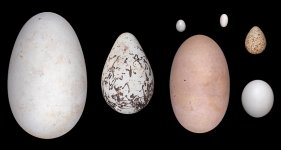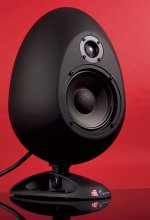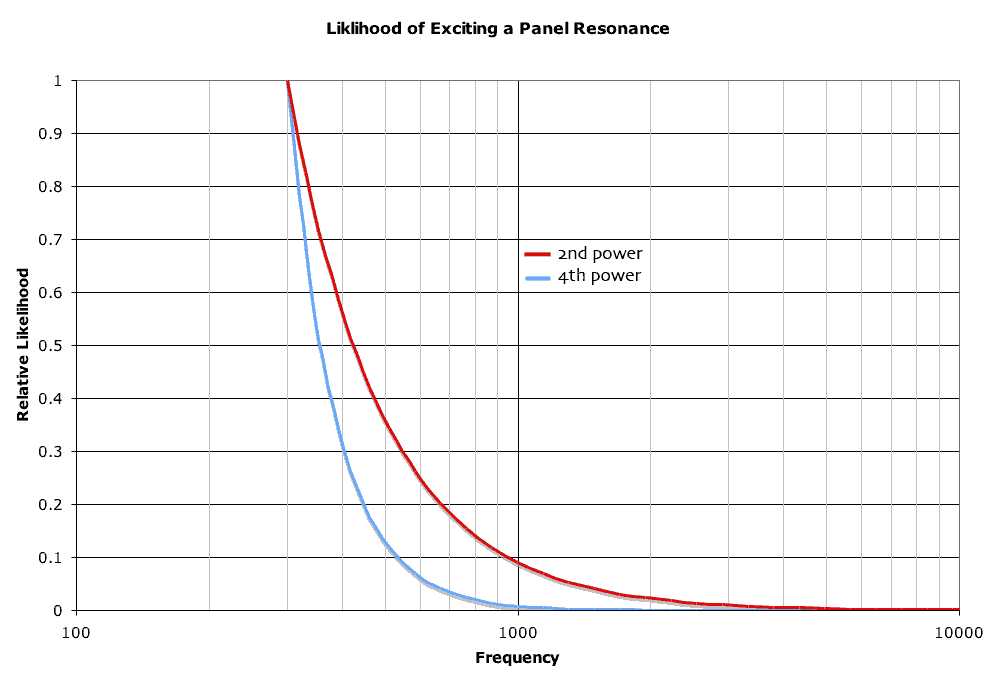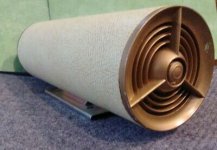High impact plastics resonates.
Everything resonates. You just have to design the box to push its (potential) resonances up high in frequency. How you do that with the plastic material you use may require some experimentation.
But as mentioned, the arch is very stiff.
A sphere has avery nice shape as far as the outside is concerend, not so much on the inside. GIven its very shape a sphere should be able to have quite thin walls and still be, effectively, non-resonant as far as the “box” goes. A single strong standing wave inside.
dave
...something that doesn't keep rolling can be an advantage.
Traditional explanations have suggested that the shape of the eggs is to ensure they don't roll too far from the nest, or that the shape allows the egg to squeeze its way more easily out of the bird's cloaca.
However, recent studies indicate that flight may influence egg shape. Birds that are good fliers tend to lay asymmetric or elliptical eggs.
Why Do Bird Eggs Have Different Shapes? Look to the Wings - The New York Times
Attachments
Everything resonates. You just have to design the box to push its (potential) resonances up high in frequency.
Move very high like polymer+concrete? Because TPU resonance is as low as woofer Fs?
Yes, I am sure:Are you sure about that? PA speakers in plastic to me seems like on the low end side with the primary purpose of saving cost and reducing weight and at the same time be more weather resistant compared to what used to be chipboards/ikea style which of course isn’t good either. More expensive PA are still solid ply to my knowledge. But as I said I’m no expert.
RCF HDM 45-A 15" Professional 2-Way 2200W Active Speaker HD45-A
$2,000 each.
Enclosure is made from polypropylene. True, it is more weather resistant compared to de-facto standard baltic birch ply enclosure material in professional reinforcement loudspeakers.
Cost is not a Technical parameter.
Weight/Density/flexibility/shape/resonances are.
Plastics by definition can get incredibly complex shapes unthinkable in anything assembled out of parts cut from flat sheet materials.
CNC can help make complex parts out of wood, but then it´s an incredibly slow and clumsy way to produce objects "one by one" .... ugh!!!!
Not that I am a "Plastic fanatic" by any means, 3D printing is even more slow and clumsy.
Weight/Density/flexibility/shape/resonances are.
Plastics by definition can get incredibly complex shapes unthinkable in anything assembled out of parts cut from flat sheet materials.
CNC can help make complex parts out of wood, but then it´s an incredibly slow and clumsy way to produce objects "one by one" .... ugh!!!!
Not that I am a "Plastic fanatic" by any means, 3D printing is even more slow and clumsy.
Speaker thickness plastic is a PITA.
You will need multiple layers, honeycombs, foam cores and so on.
Expensive, slow, unpredictable as it is a new process.
And a sphere, another new complication.
Been processing plastics since 1993...
You will need multiple layers, honeycombs, foam cores and so on.
Expensive, slow, unpredictable as it is a new process.
And a sphere, another new complication.
Been processing plastics since 1993...
Last edited:
Try this if you can:
College resonator...

This is it
Great bass, clear treble.
Old earthenware pot (the pores get filled up, so every year everybody buys a new one, and these get scrapped). Used as water storage here in India.
So yes your idea may work.
You can even use this as a former or shell if you want to make one in fiberglass.
New ones are $2 max. here..
Have fun.
College resonator...

This is it
Great bass, clear treble.
Old earthenware pot (the pores get filled up, so every year everybody buys a new one, and these get scrapped). Used as water storage here in India.
So yes your idea may work.
You can even use this as a former or shell if you want to make one in fiberglass.
New ones are $2 max. here..
Have fun.
Last edited:
Pots used to keep water cool in your hot climate I presume.
Water seeps through the microscopic pores to the outside of the pot where it evaporates and cools down the pot.
Just like perspiring helps keep us cool! 😎
Water seeps through the microscopic pores to the outside of the pot where it evaporates and cools down the pot.
Just like perspiring helps keep us cool! 😎
Exactly.
And the pores fill up with salt and fine earth, so they are changed every year or maybe sooner..
The old ones are scrap, or they can be used to store water, or like this.
Really adds bass, not kidding.
You can try with ceramic jar, or glass I suppose. You may have to line it if treble becomes too much.
I did this once with 3" speakers on the open side of a cardboard tube left over from sticky tape. Put speaker on tube, and put it firing up on table...
Nice.
And the pores fill up with salt and fine earth, so they are changed every year or maybe sooner..
The old ones are scrap, or they can be used to store water, or like this.
Really adds bass, not kidding.
You can try with ceramic jar, or glass I suppose. You may have to line it if treble becomes too much.
I did this once with 3" speakers on the open side of a cardboard tube left over from sticky tape. Put speaker on tube, and put it firing up on table...
Nice.
Last edited:
I also experimented with that in my teenage years!I did this once with 3" speakers on the open side of a cardboard tube left over from sticky tape. Put speaker on tube, and put it firing up on table...
In fact, commercial versions of the loudspeaker in tube idea were sold to connect to the earphone socket of small transistor radios to boost their volume.
Attachments
Antique looking thing...how old is it?
And yes, big speakers sound nice if connected to lower rated amps, like in this case the pocket transistor would be low powered for the bigger speaker.
And yes, big speakers sound nice if connected to lower rated amps, like in this case the pocket transistor would be low powered for the bigger speaker.
The diameter of the driver in the tube was no more than 3", but the tube added that extra driven air volume that a tiny pocket transistor radio speaker lacked.
Result: a fuller, bassier (more resonant) sound.
Result: a fuller, bassier (more resonant) sound.
It is well preserved for such an old thing...
I hope it has not deteriorated in sound quality.
Back to topic:
Use two halves, and attain a shape like this.
But frankly it is a very big effort for a paltry advantage.
Fiberglass is the only viable alternative to 3D printing, and acoustically you do not achieve much.
Proceed with caution.
Oh, and one more thing: see if marine grade speaker housings are available, they may be plastic or fiberglass, in any case more weather resistant compared to ordinary indoor speakers.
Or get complete units, with drivers.
I hope it has not deteriorated in sound quality.
Back to topic:
Use two halves, and attain a shape like this.
But frankly it is a very big effort for a paltry advantage.
Fiberglass is the only viable alternative to 3D printing, and acoustically you do not achieve much.
Proceed with caution.
Oh, and one more thing: see if marine grade speaker housings are available, they may be plastic or fiberglass, in any case more weather resistant compared to ordinary indoor speakers.
Or get complete units, with drivers.
Last edited:
I also experimented with that in my teenage years!
In fact, commercial versions of the loudspeaker in tube idea were sold to connect to the earphone socket of small transistor radios to boost their volume.
😱 😱 😱 😱
You have the Time Machine or a certain De Lorean parked in your garage!!!!

That wast the very first speaker I used with my very first SS amplifier: a single ended 12V fed ASZ15 or AD149
I burnt a couple until I was asked by a kind salesman "what did you use as a heat sink?"
"HEAT SINK? .... WHAT heat sink?"😕

Maybe, perhaps we should reconsider whether the advantages of a spherical polymer enclosure overcome the many disadvantages...?
It sounds rather difficult to build. As Planet10 pointed out, another disadvantage is a large acoustical resonance where the diameter equals the half wavelength.
So what again are the advantages?
It sounds rather difficult to build. As Planet10 pointed out, another disadvantage is a large acoustical resonance where the diameter equals the half wavelength.
So what again are the advantages?
- Home
- Loudspeakers
- Multi-Way
- Plastic Speaker Cabinet - How I calculate the thickness?



